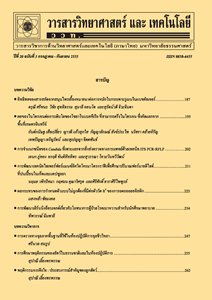การคัดเลือกแบคทีเรียแลคติกและใช้เป็นต้นเชื้อบริสุทธิ์ในการหมักปลาส้ม
Main Article Content
Abstract
บทคัดย่อ
งานวิจัยนี้มีวัตถุประสงค์เพื่อศึกษาสมบัติของแบคทีเรียแลคติกที่คัดแยกได้จากปลาส้มที่ผลิตในจังหวัดพะเยา จากนั้นคัดเลือกไอโซเลทและปริมาณของแบคทีเรียแลคติกที่เหมาะสม เพื่อใช้เป็นต้นเชื้อบริสุทธิ์ในการหมักปลาส้ม โดยการนำแบคทีเรียแลคติก จำนวน 15 ไอโซเลท มาตรวจสอบปริมาณกรดโดยรวม ปริมาณกรดแลคติก และความสามารถในการยับยั้งแบคทีเรีย Escherichia coli, Staphylococcus aureus และ Salmonella sp. ผลการทดลองพบว่า Leuconostoc mesenteroides ไอโซเลท LM2 ผลิตกรดโดยรวมและกรดแลคติกได้สูงที่สุด Lactobacillus plantarum ไอโซเลท LPB3 ไอโซเลท LPB1 และ Wissella cibaria ไอโซเลท WCD สามารถยับยั้ง E. coli, S. aureus และ Salmonella sp. ได้ดีที่สุดตามลำดับ จึงนำแบคทีเรียแลคติกทั้ง 4 ไอโซเลท นี้ มาเตรียมเป็นต้นเชื้อบริสุทธิ์แบบผสมที่ 104, 106 และ 108 ซีเอฟยูต่อมิลลิลิตร เติมลงในปลาส้มก่อนการหมัก ที่ความเข้มข้นร้อยละ 1 (ปริมาตรต่อน้ำหนัก) อีกทั้งยังมีการเติมต้นเชื้อบริสุทธิ์แบคทีเรียแลคติกแบบผสมร่วมกับเชื้อแบคทีเรีย E. coli, S. aureus หรือ Salmonella sp. เพื่อศึกษาการยับยั้งการเจริญของแบคทีเรีย ซึ่งพบว่าต้นเชื้อบริสุทธิ์แบคทีเรียแลคติกแบบผสมที่ 108 ซีเอฟยูต่อมิลลิลิตร เป็นปริมาณที่เหมาะสมในทั้งสองการทดลองคุณภาพทางประสาทสัมผัสของปลาส้มที่มีการเติมต้นเชื้อบริสุทธิ์แบคทีเรียแบบเชื้อผสมที่ 104, 106 และ 108 ซีเอฟยูต่อมิลลิลิตร ไม่แตกต่างกันอย่างมีนัยสำคัญ (p>0.05) ยกเว้นด้านความเปรี้ยว (p£0.05) ผลการศึกษาในครั้งนี้สรุปได้ว่าต้นเชื้อบริสุทธิ์แบคทีเรียแลคติกแบบผสมที่ 108 ซีเอฟยูต่อมิลลิลิตร เป็นปริมาณที่เหมาะสมในการหมักปลาส้ม
คำสำคัญ : ปลาส้ม; แบคทีเรียแลคติก; ต้นเชื้อบริสุทธิ์; กรดโดยรวม; การยับยั้งแบคทีเรีย
Abstract
The objective of this research was to study characteristics of the lactic acid bacteria (LAB) isolated from Pla-som produced in Phayao then select the LAB isolates and suitable amount and use as a starter culture for Pla-som fermentation. Fifteen isolates of LAB were studied for total acid content, lactic acid content and antibacterial activity against Escherichia coli, Staphylococcus aureus and Salmonella sp. The results showed that Leuconostoc mesenteroides isolate LM2 produced the highest amount of total acid and lactic acid. Lactobacillus plantarum, isolate LPB3, isolate LPB1 and Wissella cibaria isolate WCD performed the best inhibition among other isolates against E. coli, S. aureus and Salmonella sp., respectively. These 4 isolates were prepared as LAB mixed starter cultures at 104, 106 and 108 CFU/ml and added into Pla-som before fermentation at 1 % (v/w). We also added LAB mixed starter cultures with E. coli, S. aureus or Salmonella sp. to study antibacterial activity. It was shown that the 108 CFU/ml LAB mixed starter culture was an appropriate amount for both conditions. Sensory qualities of Pla-som added with LAB mixed starter cultures at 104, 106 and 108 CFU/ml were similar (p > 0.05) regardless of amount, except for sour taste (p £ 0.05). Based on these findings, the LAB mixed starter cultures at 108 CFU/ml appears to be an effective amount for Pla-som fermentation.
Keywords: Pla-som; lactic acid bacteria; starter culture; total acid; antibacterial activity

